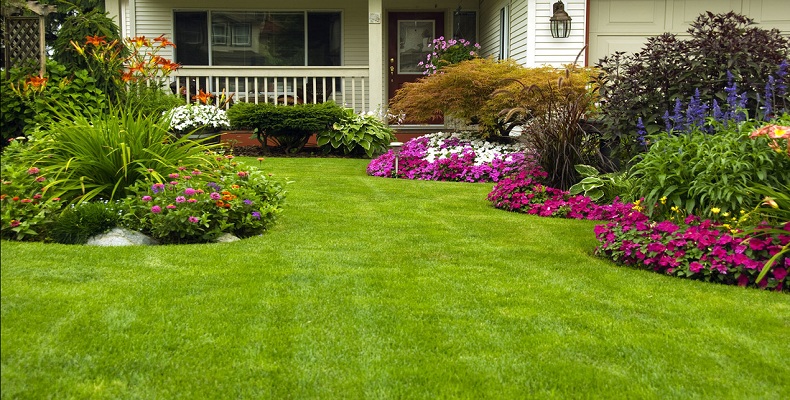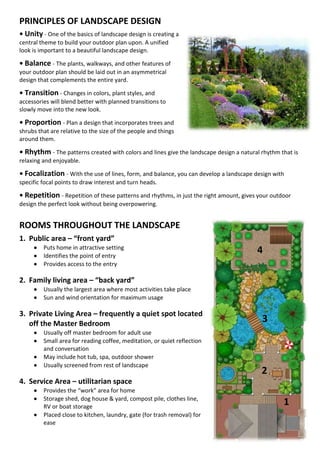Landscape Design Things To Know Before You Buy
Table of ContentsThe smart Trick of Landscape Design That Nobody is Talking AboutLandscape Design Things To Know Before You Get ThisThe 5-Minute Rule for Landscape DesignThe Only Guide for Landscape Design7 Simple Techniques For Landscape Design
A backyard can normally be split right into 3 locations: public (the front lawn), private (the back backyard), and service (usually the side yard). The area of task areas depends mainly on the type of location, the size of room required, the type of task, and the desired closeness to various other activities and frameworks.The outside wall of the home often works as the first wall or starting point of an outside space. Inappropriate uses need to be separated, and related activities, such as food preparation and dining, must be placed with each other to make the backyard extra effective and pleasurable. When making use of hardscape to develop areas, use building and construction material comparable to that utilized in your house for continuity from the home right into the garden.
Connected spaces. Credit History: Gail Hansen, UF/IFAS Making use of comparable hardscape attributes and repeating plants pulls the eye around the garden.
Facts About Landscape Design Revealed

For psychological convenience plants are made use of as physical or implied barriers for privacy and safety and security. Physical obstacles block both the view and access to a room and consist of fences, wall surfaces and plant bushes. Implied obstacles, commonly reduced expanding plants, obstruct accessibility but not the view (Figure 9). Various other features of plants consist of cleansing the air, protecting against disintegration and soil loss, retaining moisture in the dirt, and returning natural matter to the dirt.
Physical and implied barriers. Credit Scores: Gail Hansen, UF/IFAS For these factors, the kinds of plants to be used (such as trees, bushes, or groundcovers) ought to be chosen in the onset of planning (Landscape Design). Plant types are selected for their functional capabilities to ensure that their future purpose and called for room can be taken into consideration at the exact same time

The Landscape Design Ideas
Each plant mass is in front of, behind, or alongside, one more mass. Figure 11. Horizontal plant layers. Credit History: Gail Hansen, UF/IFAS Number 12. Vertical plant layers. Landscape Design. Credit Score: Gail Hansen, UF/IFAS Repeating plants within a mass and duplicating masses with comparable plants ties the garden with each other. The specific plant attributes need to be taken into consideration to effectively layer and mass plants.
All plant compositions begin with the primary structure plants, the big, mainly evergreen history plants-such as the trees and large shrubs. These plants different or enframe spaces, manage the dimension of the area, and offer the beginning point for selecting the proper features of the 2nd layer, midground plants, for massing and infill.
Vital points in the yard should be highlighted by the usage of unique plants, unique structures, or garden accessories. Noting limits or entries to rooms can be performed with gateways, arbors, and steps, or via using unique and colorful plants. The kind and/or design motif of the garden will usually assist establish the vital points and just how they must be highlighted.
Various other essential places in the yard are prime focus, which is made use of to visually organize a landscaped location. The type of centerpiece usually depends on the viewing viewpoint. Various point of views or perspectives can expose various structures in the landscape that might need a range of prime focus. Contrasting appearance, shape, dimension and color will capture and hold the eye.
A Biased View of Landscape Design
Figure 13. Plant types. Credit Score: Gail Hansen, UF/IFAS After type, appearance is the next dominant feature of a plant; coarse, medium and fine structures can be utilized for comparison and focus in the landscape. Type and structure both trump sites color in the yard for many of the year. However, during certain periods, color will certainly be one of the most noticeable feature of the yard.
The pleasant fragrance of plants, the audio of wind in the site link trees, the audio and appearance of water, and the colors and textures of sculptures, pots and yard furniture all include to the experience of the garden. One information that is often overlooked is the result of light on the aesthetics of the plants.

The 7-Minute Rule for Landscape Design
It is necessary to recognize the eventual mature dimension of plants so they can be put in the right area and spaced correctly when they are mounted. Providing plants space to expand is a difficulty due to the fact that the usual mature size is generally based upon ideal growing problems and the ecological problems of a site may create a plant to grow larger or remain smaller sized.